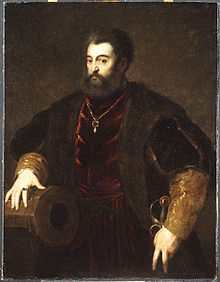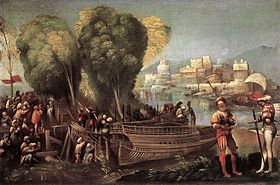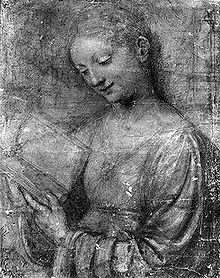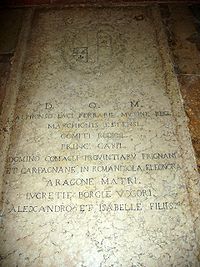- Alfonso I d'Este, Duke of Ferrara
-
"Alfonso d'Este" redirects here. For the later duke of this name, see Alfonso II d'Este, Duke of Ferrara.
Alfonso d'Este Duke of Ferrara, Modena and Reggio 
Alfonso d'Este, after Titian (attributed to Bastianino); Alfonso leans on a cannon, holding his sword Spouse(s) Anna Sforza
Lucrezia BorgiaIssue Ercole II d'Este, Duke of Ferrara
Ippolito II d'Este
Alessandro d'Este
Leonora d'Este
Francesco d'Este, Marchese di Massalombarda
Isabella Maria d'Este
Alfonso d'Este (illegitimate, father of Cesare d'Este)Noble family Este Father Ercole I d'Este Mother Leonora of Naples Born 21 July 1476
Subiaco, ItalyDied 31 October 1534 (aged 58)
FerraraAlfonso d'Este (21 July 1476 – 31 October 1534) was Duke of Ferrara during the time of the War of the League of Cambrai.
Contents
Biography
He was the son of Ercole I d'Este and Leonora of Naples. In the first year of his rule he uncovered a plot by his brother Ferrante and half-brother Giulio d'Este, directed against him and his other brother Ippolito. In September 1506 a trial for lèse majesté and high treason was held and, as expected, the death sentence was passed, but just as Ferrante and Giulio were about to mount the gallows they were informed that the duke had commuted their sentence to life imprisonment. They were led away to two cells in the Torre dei Leoni. Ferrante died in his cell after 34 years of imprisonment, while Giulio held on until he was pardoned in 1559, after 53 years of imprisonment. After his release, Giulio was ridiculed in the streets of Ferrara for his outdated clothes and died in 1561.
In the Italian Wars Alfonso preserved his precarious position among the contending powers by flexibility and vigilance and the unrivalled fortifications of Ferrara; he entered the League of Cambrai against Venice and remained an ally of Louis XII of France even after Pope Julius II had made peace with Venice; when the Bolognesi rebelled against Julius and toppled Michelangelo's bronze statue of the Pope from above the gate, Alfonso received the shards and recast them as a cannon named La Giulia, which he set on the ramparts of the castello: in 1510 Julius excommunicated him and declared his fiefs forfeit, thereby adding Ferrara to the Papal States; Alfonso then fought successfully against the Venetian and Papal armies, gaining the Battle of Polesella, capturing Bologna, and playing a major part in the French victory at the Battle of Ravenna (1512). These successes were based on Ferrara's artillery, produced in his own foundry which was the best of its time. In both of his portraits by Titian, (Compare illutration above) he poses with his arm across the mouth of one of his cannon.
In 1526–1527 Alfonso participated in the expedition of Charles V, Holy Roman Emperor and king of Spain, against Pope Clement VII, and in 1530 the pope again recognized him as possessor of the forfeited duchies of Modena and Reggio.
Alfonso's first wife was Anna Sforza, the sister of Gian Galeazzo Sforza. His second wife was Lucrezia Borgia.
Like his brother Ippolito I, Cardinal d'Este, he was one of the great patrons of art of his time: for him the elderly Giovanni Bellini painted The Feast of the Gods in 1514, Bellini's last completed painting. He turned to Bellini's pupil, Titian, for a sequence of paintings. In 1529 Alfonso created the most magnificent gallery of his time, his studiolo or camerino d'alabastro ('small alabaster room'), now usually known as his "Camerino", in order to better display his works of art against white marble-veneered walls under a gilded ceiling[1]. The pallor of the marble led to the name of this room as the chamber of alabaster. There are documents from Mario Equicola on 9 October 1511, noting plans for painting of a room in Ferrara, in which six fables (fabule) or histories (istorie) shall be placed. I have already found them and have presented them in writing." A letter from Alfonso, dated 14 November 1514, authorized payment to Giovanni Bellini, the first painting completed for the chamber.
 Aeneas and Achates on the Libyan shore, painted by Dosso Dossi for Alfonso's camerino d'alabastro (National Gallery of Art, Washington).
Aeneas and Achates on the Libyan shore, painted by Dosso Dossi for Alfonso's camerino d'alabastro (National Gallery of Art, Washington).
Titian is known to have painted two portraits of Alfonso: the first was widely acclaimed, singled out by Michelangelo and coerced as a diplomatic gift by Charles V, Holy Roman Emperor; Alfonso induced Titian to paint a free replica, which the artist of the painting illustrated above has adapted for his model.[2] Over the next two decades, Titian added three more paintings: The Worship of Venus (Museo del Prado, Madrid), The Bacchanal of the Andrians (Prado, Madrid), and Bacchus and Ariadne (National Gallery, London). Dosso Dossi produced another large bacchanal, and he also contributed ceiling decorations and a painted frieze for the cornice, depicting scenes from the Aeneid, which gained immediacy by showing the heroes in contemporary dress (illustration, left). All the bacchanals in the Alabaster Chamber dealt with love, and some refer to marriage. After the Este family lost control of Ferrara in 1598, the Alabaster Chamber's paintings and sculpture were dispersed.
Alfonso inherited from Cardinal d'Este the poet Ariosto. Following in the lead of his father Ercole, who had made Ferrara into one of the musical centers of Europe, Alfonso brought some of the most famous musicians of the time to his court to work as composers, instrumentalists and singers. Musicians from northern Europe who worked at Ferrara during his reign included Antoine Brumel and Adrian Willaert, the latter of whom was to become the founder of the Venetian School, something which could not have happened without Alfonso's patronage.
When Alfonso’s grandson Alfonso II d'Este -- Robert Browning's duke of "My Last Duchess" [3] -- produced no male heir, the main d'Este line died out. A grandson of Alfonso I and cousin of Alfonso II, Cesare d'Este had been born out of wedlock. He was recognized by the Emperor but not by the Pope, who took the Duchy of Ferrara by force. Nevertheless, the House of Este continued in Modena and Reggio.
Ancestors
Alfonso's ancestors in three generations Alfonso I d'Este Father:
Ercole d'Este IPaternal Grandfather:
Niccolò III d'EstePaternal Great-grandfather:
Alberto d'EstePaternal Great-grandmother:
Isotta AlbaresaniPaternal Grandmother:
Ricciarda da SaluzzoPaternal Great-grandfather:
Thomas III of SaluzzoPaternal Great-grandmother:
Marguerite of RoussyMother:
Leonora of NaplesMaternal Grandfather:
Ferdinand I of NaplesMaternal Great-grandfather:
Alfonso V of AragonMaternal Great-grandmother:
Giraldona CarlinoMaternal Grandmother:
Isabella of TarantoMaternal Great-grandfather:
Tristan de ClermontMaternal Great-grandmother:
Catherine of TarantoSee also
References
- Taylor, Frederick Lewis (1973). The Art of War in Italy, 1494-1529. Westport: Greenwood Press. ISBN 0-8371-5025-6.
External links
Alfonso I d'Este, Duke of FerraraBorn: 21 July 1476 Died: 31 October 1534Regnal titles Preceded by
Ercole IDuke of Ferrara, Modena and Reggio
1505–1534
forfeit 1510–1530Succeeded by
Ercole II1st Generation Alfonso I, Duke of Modena · Ippolito, Cardinal d'Este · Prince Ferrante · Prince Sigismondo · Prince Alberto · Ercole, Signore of San Martino2nd Generation Prince Alessandro · Ercole II, Duke of Modena · Prince Alessandro · Francesco, Marquis of Massalombarda · Prince Alfonso · Alfonsino, Marquis of Castelnuovo · Sigismondo, Signore of San Martino · Ippolito, Cardinal d'Este
3rd Generation Prince Alfonso · Alfonso II, Duke of Modena · Cesare, Duke of Modena · Luigi, Cardinal of Ferrera · Prince Alessandro · Filipo, Marchese of San Martino4th Generation Alfonso III, Duke of Modena · Prince Cesare · Prince Obizzo · Prince Cesare · Prince Rinaldo · Prince Borso · Prince Ippolito · Prince Foresto · Prince Bonofazio · Prince Rinaldo · Prince Filiberto · Luigi, Lord of Montecchio and Scandiano · Sigismondo, Marchese of Lanzo and Borgomanero5th Generation Francesco I, Duke of Modena · Filippo Francesco, Marquess of Lanzo · Carlo Emanuele, Marquess of Lanzo6th Generation Alfonso IV, Duke of Modena · Rinaldo, Duke of Modena · Prince Tedald · Prince Almerigo · Prince Tedald · Sigismondo, Marquess of San Martino · Carlo Filiberto, Marques of Borgomanero · Sigismondo, Marchese of San Martino7th Generation Francesco II, Duke of Modena · Francesco III, Duke of Modena · Prince Gian Federico · Prince Clemente · Carlo Emanuele, Marques of Borgomanero · Carlo Filiberto, Marchese of San Martino8th Generation Prince Alfonso · Prince Francesco Constantino · Ercole III, Duke of Modena · Benedetto Filippo, Abbot of Anchin9th Generation Prince Reinaldo10th Generation Prince Josef Franz* · Francis IV, Duke of Modena* · Prince Ferdinand Karl Joseph* · Prince Maximilian* · Prince Karl*11th Generation *also Archduke of AustriaCategories:- 1476 births
- 1534 deaths
- House of Este
- Condottieri
- Dukes of Ferrara
- Dukes of Modena
- Dukes of Reggio
- Foundrymen
- Military leaders of the Italian Wars
- People excommunicated by the Roman Catholic Church
- 15th-century Italian people
- 16th-century Italian nobility
Wikimedia Foundation. 2010.


